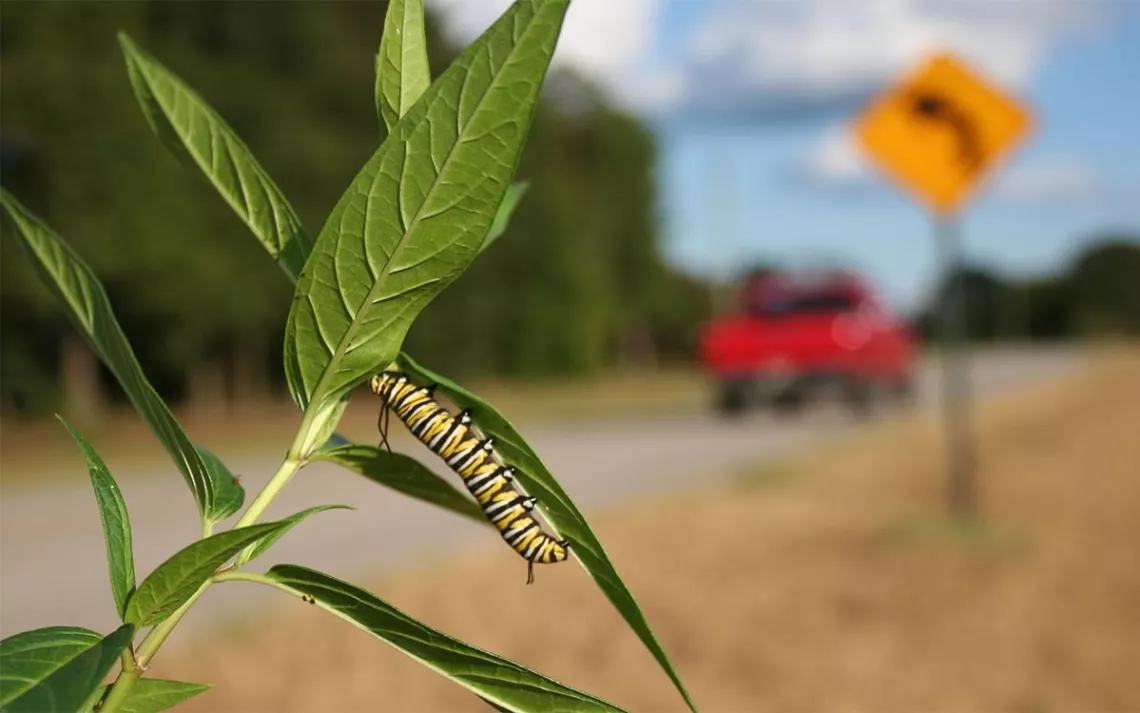What’s Killing the Monarchs? Our Roads.
25 million butterflies a year are mashed by motorists

Photo courtesy of Andy Davis
Every fall, monarch butterflies embark on their famous migration, one of the most daunting in the animal kingdom. From the United States and Canada, they fly 3,000 miles to overwinter among the oyamel fir groves of central Mexico, in the exact place that their great-grandparents did. Over the past decade, however, the number of monarchs that make it to Mexico has been shrinking, and scientists are racing to figure out why.
Andy Davis, a research scientist at the Odum School of Ecology at the University of Georgia, points out that the breeding range for monarchs is huge—48 U.S. states and eight Canadian provinces—but the numbers are declining in Mexico. This tells us, he says, that something is happening along the journey. There are a number of natural risks and stressors that monarchs face during their migration: Some get caught over the Great Lakes and drown before they make it to the other side. Others die in storms. And monarchs traveling the Eastern Seaboard fight an often-losing battle with wind before making it to a rest area.
But Davis discovered another hazard for the tiger-striped migrants—cars and trucks.
In a recent study, published in the journal Biology Letters, Davis found that the single-largest cause of monarch mortality is roadways, where some 25 million butterflies die each year—often run over or caught in windshields or grills. In less direct effects, polluted runoff from oil and salts may be altering the quality of monarch larvae. Monarch caterpillars are also stressed by roadway noise, which, over time, actually changes their stress response. Davis strapped tiny heart sensors to monarch caterpillars to monitor how they reacted to the simulated sounds of cars driving down the highway. After hearing the noise, the caterpillars’ tubular hearts raced—in most animals, an indication of stress. But after long periods of traffic noise, the caterpillars became desensitized and no longer reacted.
“We’re not sure if the stress carries over into adulthood, but we do know that a delayed stress response is a death sentence for migrating monarchs,” Davis says. Studies on salmon and migratory birds, he says, have shown that stress response is directly linked to migration success. While a number of factors may be at play, Davis says, a common denominator of controllable threats is roads.
An obvious takeaway from Davis’s research is that roadside plantings of pollinator-friendly plants put monarchs at risk. While butterfly gardens along the highway may look beautiful and seem environmentally sound, butterflies and roadways don’t mix. “We need for roadways to be as inhospitable as possible so that monarchs aren’t drawn to them,” Davis says.
Plantings for the butterflies, he says, would be more effective along the monarch’s migratory route, particularly in Texas, where monarchs roost by the tens of thousands to fatten up before heading south. The butterflies depend on nectar-producing plants, large fields of which are crucial to their migration and 80-plus-day hibernation in Mexico. Butterfly gardeners in the Lone Star State could help them complete their journey by providing nectar-rich flowers for them to enjoy. They also need to have ample open fields between Canada and Mexico to rest without the risk of getting hit by cars.
Other scientists and experts think the focus should be on planting milkweed and point to declining acreage in the Midwest due to widespread use of the weed-killer Roundup. “If you plant it, they will come,” says Dr. Herbert Wilson, a senior research associate in the College of Science at Texas A&M University. He says that ample milkweed is critically important for returning monarchs, because they need it to lay their eggs on. Wilson also points to the role of climate change: “It gets so hot that the eggs never emerge as caterpillars.” One way or the other, it’s up to humans whether the iconic monarch continues its reign.
 The Magazine of The Sierra Club
The Magazine of The Sierra Club



